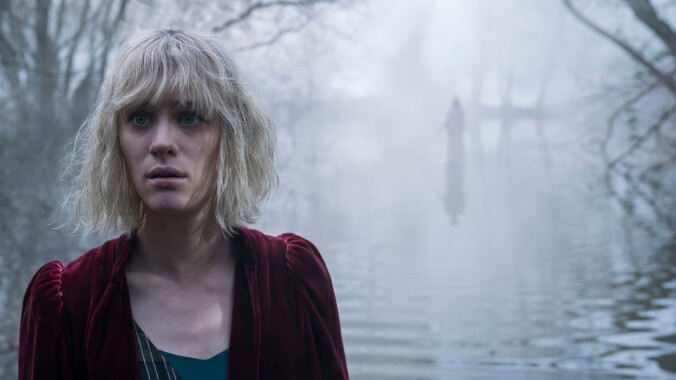It used to happen all the time: Filmmakers would come up through the flashy world of music videos, and eventually make the jump to bigger screens. The Turning director Floria Sigismondi must remember; she got her start making music videos in the 1990s, eventually amassing an impressive roster of clips for artists like David Bowie, Marilyn Manson, Fiona Apple, The White Stripes, and Christina Aguilera. Appropriately, her second feature following 2010’s rock biopic The Runaways jumps back to the era where she got her start. This adaptation of the Henry James novella The Turn Of the Screw announces right away, via a snippet about Kurt Cobain’s recent death, that it is set in the spring of 1994—nearly 100 years after Screw was first published, but now long enough ago to count as its own sort of period piece.
This means that Kate (Mackenzie Davis) is no longer a governess, at least not in so many words. She’s described as a live-in tutor and caretaker for Flora (Brooklynn Prince from The Florida Project), whose parents have died in a car crash and whose previous nanny has abruptly vanished. While her older brother Miles (Finn Wolfhard) attends boarding school, Flora lingers on the grounds of her family’s vast estate, lightly parented by a loyal, elderly maid (Barbara Marten) until Kate arrives on the scene. Flora and Kate quickly develop a friendly rapport, which is just as quickly undermined by the surprise return of Miles.
Kate hears the usual mysterious nighttime creaks and rattles, and sees the usual spectral figures out of the corner of her eye. But Miles provides a sneakier, more provocative tension as he mouths off to her and refuses to respect her personal space. Plenty of movie bad-seeds strike a contrast between a placid or adorable exterior and the unexpected menace underneath. Here, by aging up the “bad” kid by just a few years, The Turning raises some sly questions about whether Miles is evil, possessed, or simply a hormonal, entitled little jerk (which is to say, a teenage boy). That ambiguity nearly justifies the sullen mono-expressiveness of Wolfhard’s performance, which involves him affecting a slack-jawed half-sneer for much of the running time.
Wolfhard also has the unenviable task of creating a relationship with an actor who isn’t quite there. Miles is supposed to have some sort of bond with the dead groundskeeper Quint, who will be familiar to any readers of the original James book. But despite a general-outline fidelity to its source material, The Turning diffuses its immediacy by keeping no fewer than four important characters dead, missing, possibly ghostly, or otherwise offscreen. (The count goes up to five or six once Kate’s own family backstory is factored in.) This is presumably supposed to goose the movie’s haunting possibilities, but instead much of the creepy stuff feels predetermined, like a murder mystery that’s all boring suspects and no inciting crime. When Kate wanders the grounds that include an under-tended pool, a messy sewing room, and countless ornate mirrors, would-be jump scares are diminished to mere nudge-scares.
Davis gives a capable performance as a woman whose ease with children masks her own fears, at least until she gets caught in an extended game of Doll, Ghost, Or Corpse? Prince is similarly strong—she’s the rare kid actor with a believably animated but non-cutesy affect—and similarly abandoned by the story. Really, everyone in The Turning is left high and dry by an ending so baffling that it’s nearly spoiler-proof—to spoil it would require even a rudimentary understanding of what is meant to be happening in its final moments, beyond that it seems to discard the novella’s finale. (Stranger still, the movie manages to somehow end abruptly while still trailing off; images float over the end credits, vaguely teasing additional information that never arrives.) The kind of horror-movie crowds that boo at the merest hint of an ambiguous or non-twist ending may well burn theaters showing The Turning straight to the ground.
It would be easier to turn this flouting of audience expectations into a cause célèbre if Sigismondi’s strong sense of style was allowed to dominate the essentially unfinished story. The movie’s period bona fides are by turns eye-catching (layered slip dresses, platinum-dyed bangs) and disorienting (the use of ’90s-fluent 2010s indie acts like Mitski, Soccer Mommy, and Warpaint). In a better movie, this would be a subtly unnerving touch, evoking a time period without the comforting familiarity of nostalgia. In a movie as utterly lost as The Turning, everything from the performances to the production design to the music cues amount to one big pile of dirty mirrors and doll parts.













![HBO teases new Euphoria, Larry David, and much more in 2026 sizzle reel [Updated]](https://img.pastemagazine.com/wp-content/avuploads/2025/12/12100344/MixCollage-12-Dec-2025-09-56-AM-9137.jpg)




























